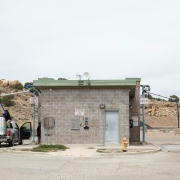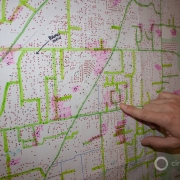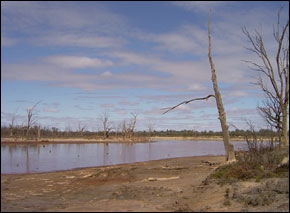Texas Water Board Approves $US 62 Billion Water Plan
Plan guides state response to drought.

The 2017 Texas water plan forecasts a 62 percent increase in municipal water demand by 2070, driven in large part by growing metropolises such as San Antonio, pictured above. Photo © J. Carl Ganter / Circle of Blue
By Brett Walton, Circle of Blue
The Texas Water Development Board approved on Thursday the newest edition of the state water plan, a document that includes $US 62 billion in capital projects over 50 years to respond to the threat of water shortages.
Every five years, Texas draws up a water plan that looks a half century into the future. The plan, based on projections of population growth, water supply, and demand, is designed to guide the state through a repeat of the worst drought on record. Texas is expected to add more than 24 million people by 2070 and existing water sources are insufficient, the plan asserts, because of population growth, groundwater depletion, and sediment buildup in reservoirs.
“This is the best plan yet. It’s the most comprehensive, detailed plan,” said Bech Bruun, chairman of the Texas Water Development Board, noting that it is the first plan to incorporate data from the historic 2011 drought, when many river basins experienced new droughts of record.
The plan emphasizes water storage, with 26 major reservoirs included in the blueprint. Conservation is the second most-common strategy for meeting demands, followed by water reuse. Though Texas sits above brackish aquifers and along the Gulf Coast, desalination is an insignificant contributor, accounting for roughly 2 percent of projected new supplies.
The plan predicts a divergence in Texas water use — away from agriculture and toward cities. Irrigation demand is expected to decline 18 percent by 2070 due to more efficient practices and shrinking groundwater tables, especially the Ogallala Aquifer, which will reduce water availability — farmers, crafty as they are, cannot tap dry aquifers. Texas’s growing cities, on the other hand, are expected to increase demand by 62 percent. The biggest centers of population growth, according to the plan, are Houston and the Dallas-Fort Worth region.
Even though Texas will be using more water, the rate of increase is slowing. Projected demands have fallen since the last state water plan was approved. Overall demand in the 2012 plan was estimated at 21.9 million acre-feet by 2060. The 2017 plan assumes that 20.9 million acre-feet will be needed in 2060, a 5 percent decrease. Municipal demand, which will overtake agriculture as the largest water-using sector by 2070, decreased 8 percent from the previous plan. Those estimates reflect the findings of recent studies that have shown large decreases in household water use in the United States in the last 16 years due to more efficient appliances and fixtures.
Plan Criticism
Texas takes a “bottom-up” approach to planning, appropriate in a geographically and economically diverse state where annual rainfall in the eastern counties is six times higher than in the west.
The state is divided into 16 regional planning groups that represent a range of interests: cities, farms, electric utilities, conservationists, groundwater regulators, and a half dozen others that are required by law to be at the table. The regional groups assess supply and demand and identify potential shortages during conditions equal to the worst drought on record. They also identify responses: new reservoirs, for instance, or conservation strategies or transferring water from farms to cities. The regional groups submit the plans to the water board which, after approval, consolidates them into a statewide plan. The board does not intervene in the regional plans.
The plan — and the planning process itself — are targets for criticism. Several groups — Environmental Defense Fund, Sierra Club, and Texas Center for Policy Studies — argued that the 83 percent projected increase in electric power water use is too high. Wind and solar energy use little to no water and are growing rapidly in Texas, they argued.
The water board said that it has hired a consultant to review the methods for calculating electric power demand, which come from a 2008 report, and that any revision would be incorporated in the next five-year planning cycle.
Another contention is that the planning process encourages regions to overstate their needs. Projects in the plan are first in line for state funding. Texas has provided some $US 1.9 billion to 60 projects that were included in the 2012 plan.
A 2014 report from the Texas Center for Policy Studies argued that the state should use more realistic demand projections that reflect the growth of municipal conservation. That report also recommended using multiple scenarios in the plan and giving a greater emphasis to ecosystem health. The new plan does recommend that the Legislature should protect five streams for having “unique ecological value.”
Other commenters said that the state should require regions to use climate change models to project how future droughts might differ from the drought of record. Still others said that the state should require strict reductions in water use during droughts. The water board responded that managing water use is not its role; it is the responsibility of the Texas Commission on Environmental Quality.
However, inclusion in the state water plan does not guarantee that a project will be built. Texas water development is regulated by a mix of groundwater districts, river basin authorities, and state, federal, and local statutes.
Brett writes about agriculture, energy, infrastructure, and the politics and economics of water in the United States. He also writes the Federal Water Tap, Circle of Blue’s weekly digest of U.S. government water news. He is the winner of two Society of Environmental Journalists reporting awards, one of the top honors in American environmental journalism: first place for explanatory reporting for a series on septic system pollution in the United States(2016) and third place for beat reporting in a small market (2014). He received the Sierra Club’s Distinguished Service Award in 2018. Brett lives in Seattle, where he hikes the mountains and bakes pies. Contact Brett Walton











